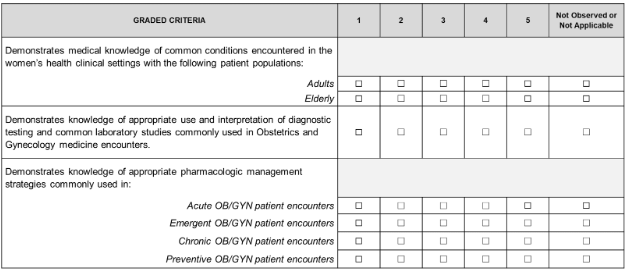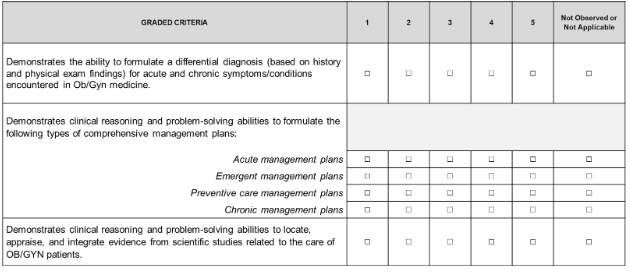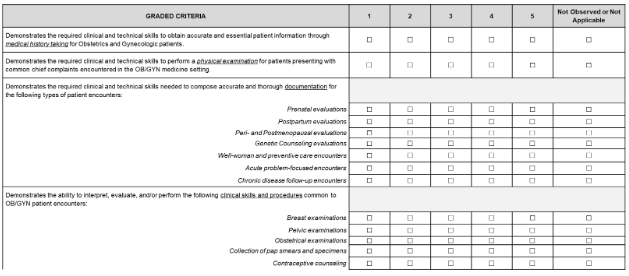BLOG
SCOTT'S THOUGHTS

Finding Solutions to Common ARC-PA Citations – Volume 14
Standard B3.03c
I’m glad you’re joining me again to examine common ARC-PA Standard citations and how to avoid them. The next most commonly cited ARC-PA Standard is B3.03c. Again, if the process you have in place is not compliant, you risk getting all of the B3.03 Standard citations. Standard B3.03c does seem to be the most common, but seeing programs cited for B3.03a, b, c, and d is not unusual.
Between March 2022 and June 2023, 15 out of 98 programs received a citation for standard B3.03c.
Why is this citation so common?
This Standard states that programs must have defined learning outcomes for women’s health, which include prenatal and gynecologic care. These learning outcomes must identify the medical knowledge, interpersonal, clinical and technical skills, professional behaviors, clinical reasoning, and problem-solving abilities that each student must attain by completing each supervised clinical practice experience (SCPE).
Note here that obstetrics is not a requirement for your students. Even if they have the opportunity for clinical practice in this field, as a program director, you should ask yourself whether that’s a complication you want to achieve. I remind you of my last blog when we imagined the formidable lengths of evaluations that, by necessity, cover multiple categories lest we be cited for “Complex Content.”
Points to remember:
There must be a perfect alignment between the women’s health learning outcomes for SCPE and the assessment modalities.
Match all terminology with the definitions in the ARC-PA glossary. I understand that sometimes, alternate terms obviously refer to the same thing as the glossary, but why add this extra step? You risk an examiner disagreeing with what is “obvious” to you. Using their terms simplifies everything.
The preceptor's evaluation of the student and the learning outcomes must be cross-walked to demonstrate assessment of all learning outcomes.
Learning outcomes themselves must be measurable and without any complex content.
Programs must triangulate assessment between learning outcomes, instructional objectives, and assessment modalities.
Finally, you must crosswalk learning outcomes against Standards B303.a and b. Crosswalking between Standards is a prime example of the benefit of using identical terminology across the board.
Strategies for Compliance
Meet all learning outcomes. If a student fails to achieve a learning outcome during the assigned clerkship, a gap analysis must be conducted to ensure the student meets competency before graduation. (Don’t worry - conducting a gap analysis will be covered in our next blog!)
Program-specific procedures must be clearly delineated in the learning outcomes and triangulated with the preceptor evaluation form.
Using a procedural passport can achieve compliance, but it is deemed unmeasurable without alignment with the learning outcomes.
B3.03c Learning Outcomes Example
The following learning outcomes represent an in-depth list of things your students should learn and perform during their rotation.
Learning Outcomes: At the completion of this clinical rotation, the PA student will possess the following medical knowledge, interpersonal, clinical, and technical skills, professional behaviors, clinical reasoning, and problem-solving abilities:
Students will demonstrate medical knowledge of clinical presentation/manifestations for common conditions (listed in the “Outline of Topics” in the course syllabus) encountered in women’s health for patients seeking medical care for the following age populations: adult and elderly.
Students will demonstrate knowledge of appropriate use and interpretation of diagnostic testing and laboratory studies commonly used for patients seeking general women’s health, prenatal, and gynecologic care.
Students will apply clinical reasoning and problem-solving abilities to formulate a differential diagnosis for symptoms/conditions commonly used for patients seeking general women’s health, prenatal, and gynecologic care.
Students will demonstrate knowledge of appropriate treatment and management strategies commonly used for patients seeking general women’s health, prenatal, and gynecologic care.
Students will demonstrate the required clinical and technical skills:
Obtain a medical history
Perform a physical examination and proper documentation for the following types of patient encounters:
Prenatal evaluations (acute and preventive)
Postpartum evaluations (acute)
Peri- and Post-menopausal chronic evaluations
Genetic counseling evaluations (preventive)
Well-women (preventive care encounters)
Emergent women’s health problem-focused encounters
Chronic disease follow-up encounters
Perform the following clinical procedures:
Breast examination
Pelvic examination
Collection of pap smear and specimens
Obstetric examination
Contraceptive counseling
I recommend being selective about these learning outcomes because you want a manageable list of procedures.
I will add, however, that you may include an “aspirational list,” but it must be precisely that. Ideally, you’d like your students to have the opportunity to learn and perform many other components of care, but make clear for the ARC-PA that these are not a requirement.
“Aspirational” outcomes might include topics like:
Demonstrate knowledge of reimbursement, billing, and coding specific to women’s health conditions.
Demonstrate professional interpersonal and communication skills, collaboration skills, cultural humility, and the ability to work effectively throughout the women’s health clinic rotation.
Alignment of Learning Outcomes and Assessment Methodology
Using the learning outcomes above, I have created these assessments using a five-point Likert Scale. You can use whatever scale of measurement that fits your program.
When you look at different populations, you can have separate areas to evaluate adult and elderly patients and separate areas for different encounters. If you can evaluate these separately, you're in good shape, eliminating the notion that you have complex content that cannot be measured.
PES Medical Knowledge

PES Clinical Reasoning and Problem-solving Abilities
Remember to avoid multiple components that you can’t evaluate simply.

PES Clinical and Technical Skills

Next time…
In the next blog, we’ll discuss how your program can delineate benchmarks for learning and instructional outcomes. When our assessments fail to meet benchmarks, our SSR must reflect that we noted that failure, measured it, and made a plan for dealing with it. In that vein, I’ll explain how to conduct the necessary gap analysis.

Finding Solutions to Common ARC-PA Citations – Volume 14
Standard B3.03c
I’m glad you’re joining me again to examine common ARC-PA Standard citations and how to avoid them. The next most commonly cited ARC-PA Standard is B3.03c. Again, if the process you have in place is not compliant, you risk getting all of the B3.03 Standard citations. Standard B3.03c does seem to be the most common, but seeing programs cited for B3.03a, b, c, and d is not unusual.
Between March 2022 and June 2023, 15 out of 98 programs received a citation for standard B3.03c.
Why is this citation so common?
This Standard states that programs must have defined learning outcomes for women’s health, which include prenatal and gynecologic care. These learning outcomes must identify the medical knowledge, interpersonal, clinical and technical skills, professional behaviors, clinical reasoning, and problem-solving abilities that each student must attain by completing each supervised clinical practice experience (SCPE).
Note here that obstetrics is not a requirement for your students. Even if they have the opportunity for clinical practice in this field, as a program director, you should ask yourself whether that’s a complication you want to achieve. I remind you of my last blog when we imagined the formidable lengths of evaluations that, by necessity, cover multiple categories lest we be cited for “Complex Content.”
Points to remember:
There must be a perfect alignment between the women’s health learning outcomes for SCPE and the assessment modalities.
Match all terminology with the definitions in the ARC-PA glossary. I understand that sometimes, alternate terms obviously refer to the same thing as the glossary, but why add this extra step? You risk an examiner disagreeing with what is “obvious” to you. Using their terms simplifies everything.
The preceptor's evaluation of the student and the learning outcomes must be cross-walked to demonstrate assessment of all learning outcomes.
Learning outcomes themselves must be measurable and without any complex content.
Programs must triangulate assessment between learning outcomes, instructional objectives, and assessment modalities.
Finally, you must crosswalk learning outcomes against Standards B303.a and b. Crosswalking between Standards is a prime example of the benefit of using identical terminology across the board.
Strategies for Compliance
Meet all learning outcomes. If a student fails to achieve a learning outcome during the assigned clerkship, a gap analysis must be conducted to ensure the student meets competency before graduation. (Don’t worry - conducting a gap analysis will be covered in our next blog!)
Program-specific procedures must be clearly delineated in the learning outcomes and triangulated with the preceptor evaluation form.
Using a procedural passport can achieve compliance, but it is deemed unmeasurable without alignment with the learning outcomes.
B3.03c Learning Outcomes Example
The following learning outcomes represent an in-depth list of things your students should learn and perform during their rotation.
Learning Outcomes: At the completion of this clinical rotation, the PA student will possess the following medical knowledge, interpersonal, clinical, and technical skills, professional behaviors, clinical reasoning, and problem-solving abilities:
Students will demonstrate medical knowledge of clinical presentation/manifestations for common conditions (listed in the “Outline of Topics” in the course syllabus) encountered in women’s health for patients seeking medical care for the following age populations: adult and elderly.
Students will demonstrate knowledge of appropriate use and interpretation of diagnostic testing and laboratory studies commonly used for patients seeking general women’s health, prenatal, and gynecologic care.
Students will apply clinical reasoning and problem-solving abilities to formulate a differential diagnosis for symptoms/conditions commonly used for patients seeking general women’s health, prenatal, and gynecologic care.
Students will demonstrate knowledge of appropriate treatment and management strategies commonly used for patients seeking general women’s health, prenatal, and gynecologic care.
Students will demonstrate the required clinical and technical skills:
Obtain a medical history
Perform a physical examination and proper documentation for the following types of patient encounters:
Prenatal evaluations (acute and preventive)
Postpartum evaluations (acute)
Peri- and Post-menopausal chronic evaluations
Genetic counseling evaluations (preventive)
Well-women (preventive care encounters)
Emergent women’s health problem-focused encounters
Chronic disease follow-up encounters
Perform the following clinical procedures:
Breast examination
Pelvic examination
Collection of pap smear and specimens
Obstetric examination
Contraceptive counseling
I recommend being selective about these learning outcomes because you want a manageable list of procedures.
I will add, however, that you may include an “aspirational list,” but it must be precisely that. Ideally, you’d like your students to have the opportunity to learn and perform many other components of care, but make clear for the ARC-PA that these are not a requirement.
“Aspirational” outcomes might include topics like:
Demonstrate knowledge of reimbursement, billing, and coding specific to women’s health conditions.
Demonstrate professional interpersonal and communication skills, collaboration skills, cultural humility, and the ability to work effectively throughout the women’s health clinic rotation.
Alignment of Learning Outcomes and Assessment Methodology
Using the learning outcomes above, I have created these assessments using a five-point Likert Scale. You can use whatever scale of measurement that fits your program.
When you look at different populations, you can have separate areas to evaluate adult and elderly patients and separate areas for different encounters. If you can evaluate these separately, you're in good shape, eliminating the notion that you have complex content that cannot be measured.
PES Medical Knowledge

PES Clinical Reasoning and Problem-solving Abilities
Remember to avoid multiple components that you can’t evaluate simply.

PES Clinical and Technical Skills

Next time…
In the next blog, we’ll discuss how your program can delineate benchmarks for learning and instructional outcomes. When our assessments fail to meet benchmarks, our SSR must reflect that we noted that failure, measured it, and made a plan for dealing with it. In that vein, I’ll explain how to conduct the necessary gap analysis.
Don't miss out on future events!
Subscribe to our newsletter

© 2025 Scott Massey Ph.D. LLC

